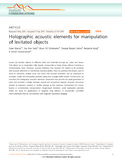Mostrar el registro sencillo del ítem
Holographic acoustic elements for manipulation of levitated objects
| dc.creator | Marzo Pérez, Asier | es_ES |
| dc.creator | Seah, Sue Ann | es_ES |
| dc.creator | Drinkwater, Bruce W. | es_ES |
| dc.creator | Sahoo, Deepak Ranjan | es_ES |
| dc.creator | Long, Benjamin | es_ES |
| dc.creator | Subramanian, Sriram | es_ES |
| dc.date.accessioned | 2016-06-06T09:41:50Z | |
| dc.date.available | 2016-06-06T09:41:50Z | |
| dc.date.issued | 2015 | |
| dc.identifier.issn | 2041-1723 (Electronic) | |
| dc.identifier.uri | https://hdl.handle.net/2454/20848 | |
| dc.description | Incluye material complementario | es_ES |
| dc.description.abstract | Sound can levitate objects of different sizes and materials through air, water and tissue. This allows us to manipulate cells, liquids, compounds or living things without touching or contaminating them. However, acoustic levitation has required the targets to be enclosed with acoustic elements or had limited manoeuvrability. Here we optimize the phases used to drive an ultrasonic phased array and show that acoustic levitation can be employed to translate, rotate and manipulate particles using even a single-sided emitter. Furthermore, we introduce the holographic acoustic elements framework that permits the rapid generation of traps and provides a bridge between optical and acoustical trapping. Acoustic structures shaped as tweezers, twisters or bottles emerge as the optimum mechanisms for tractor beams or containerless transportation. Single-beam levitation could manipulate particles inside our body for applications in targeted drug delivery or acoustically controlled micro-machines that do not interfere with magnetic resonance imaging. | en |
| dc.description.sponsorship | This work has been supported by the EC within the seventh framework programme through both the European Research Council (Starting Grant Agreement 278576) and the FET Open Scheme (under grant agreement no. 309191). | en |
| dc.format.mimetype | application/pdf | en |
| dc.format.mimetype | application/zip | en |
| dc.language.iso | eng | en |
| dc.publisher | Nature Publishing Group | en |
| dc.relation.ispartof | Nature Communications, 6 : 8661 | en |
| dc.rights | © 2015 Macmillan Publishers Limited. All rights reserved | en |
| dc.rights | This work is licensed under a Creative Commons Attribution 4.0 International License. The images or other third party material in this article are included in the article’s Creative Commons license, unless indicated otherwise in the credit line; if the material is not included under the Creative Commons license, users will need to obtain permission from the license holder to reproduce the material. | en |
| dc.rights.uri | http://creativecommons.org/licenses/by/4.0/ | |
| dc.subject | Levitation | en |
| dc.subject | Holographic acoustic elements | en |
| dc.title | Holographic acoustic elements for manipulation of levitated objects | en |
| dc.type | Artículo / Artikulua | es |
| dc.type | info:eu-repo/semantics/article | en |
| dc.contributor.department | Ingeniería Matemática e Informática | es_ES |
| dc.contributor.department | Matematika eta Informatika Ingeniaritza | eu |
| dc.rights.accessRights | Acceso abierto / Sarbide irekia | es |
| dc.rights.accessRights | info:eu-repo/semantics/openAccess | en |
| dc.identifier.doi | 10.1038/ncomms9661 | |
| dc.relation.projectID | info:eu-repo/grantAgreement/European Commission/FP7/278576 | en |
| dc.relation.projectID | info:eu-repo/grantAgreement/European Commission/FP7/309191 | en |
| dc.relation.publisherversion | https://dx.doi.org/10.1038/ncomms9661 | |
| dc.type.version | Versión publicada / Argitaratu den bertsioa | es |
| dc.type.version | info:eu-repo/semantics/publishedVersion | en |



